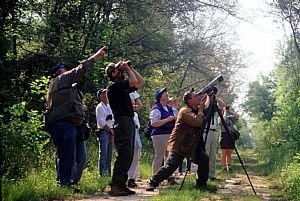
"Our Backstreets" #8
Watching the Birdies
The rites of spring are upon us, when a young man's thoughts turn to love, a housewife's thoughts turn to wardrobe rotation and offloading junk to the Salvation Army, and a birder's thoughts turn to LBJs and warblers. I fall into the second two categories, but since house cleaning is repetitive and of no interest to anyone besides S. C. Johnson Wax, I prefer to talk about this interest I share with millions of people all over the world that, to a nonbirder, must seem terribly square.
Square it may be, but birders can be as serious about their sport as athletes are about theirs, maybe moreso. I'll get to the dark side of birding later. First, I will explain about birding. I mentioned LBJs. That is shorthand for "little brown jobs," usually sparrows that escape everyone's notice, that is, except the avid birdwatchers alongside whom I frequently stand and hope to overhear an identification. I'm not the type to study my field guides for weeks in anticipation of the biannual irruption of small feathered creatures passing
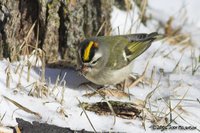 from one place to another thousands of miles away. I am often stumped by the simplest of birds, say, a golden-crowned kinglet, which is among the most delightful of animals drawing breath on this planet. How is it that I can look at this tiny, far-from-shy bird flitting close enough for naked-eye identification and still have to run to my Peterson's guide, warped and stiff from the time my mother dropped it in some bogland during a thoroughly miserable day of birding--rather, failing to bird--in the rain.
from one place to another thousands of miles away. I am often stumped by the simplest of birds, say, a golden-crowned kinglet, which is among the most delightful of animals drawing breath on this planet. How is it that I can look at this tiny, far-from-shy bird flitting close enough for naked-eye identification and still have to run to my Peterson's guide, warped and stiff from the time my mother dropped it in some bogland during a thoroughly miserable day of birding--rather, failing to bird--in the rain.Yet I must say that after stalking the wild bird for more than 20 years, some of it seems finally to have sunk in. I can quickly spot at a distance a
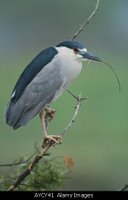 bird that just doesn't look ordinary, and my best guesses of briefly glanced specimens seem to be right more often than not. For example, as I gazed out the window of the Skokie Swift train (named for the chimney swift, a lovely whiskered bird), I spied a bulbous bird with a white breast, a black cap, and naked legs perched in a tree. Clearly not a hawk, because of the legs. There was water around. Must be a black-crowned night heron. Not many novice birders would call that bird. They'd be too cautious and call it a red-tailed hawk despite the legs, or they'd pick out a rarity that, if correct, would have every birder within a four-state radius camping out looking at it or a bird that doesn't occur in the area. I have made these errors many times, but not anymore.
bird that just doesn't look ordinary, and my best guesses of briefly glanced specimens seem to be right more often than not. For example, as I gazed out the window of the Skokie Swift train (named for the chimney swift, a lovely whiskered bird), I spied a bulbous bird with a white breast, a black cap, and naked legs perched in a tree. Clearly not a hawk, because of the legs. There was water around. Must be a black-crowned night heron. Not many novice birders would call that bird. They'd be too cautious and call it a red-tailed hawk despite the legs, or they'd pick out a rarity that, if correct, would have every birder within a four-state radius camping out looking at it or a bird that doesn't occur in the area. I have made these errors many times, but not anymore.I also know my habitats. Edge habitat, the place where one type of habitat collides with another, is the best place to spy migrant birds. I can just look at a crowd of bushes or a tangle of na
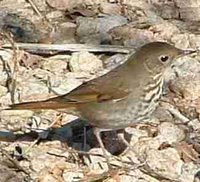 ked branches and know I'll find something I don't usually see. Rosehill Cemetery is one of my favorite spots because it has a wide variety of habitats all pouring over each other. The open, grassy areas where the grave markers stand are good places for thrushes, better known to most people as robins. Of course, robins aren't the only type of thrush, and if you look closely, you'll notice that some of the birds you think are robins aren't red. More often than not they're brown-speckled hermit thrushes, who boast a lovely song characteristic of their bird family.
ked branches and know I'll find something I don't usually see. Rosehill Cemetery is one of my favorite spots because it has a wide variety of habitats all pouring over each other. The open, grassy areas where the grave markers stand are good places for thrushes, better known to most people as robins. Of course, robins aren't the only type of thrush, and if you look closely, you'll notice that some of the birds you think are robins aren't red. More often than not they're brown-speckled hermit thrushes, who boast a lovely song characteristic of their bird family.I like to drive along a gravel road barely wider than a path to seek out the smaller birds that prefer its
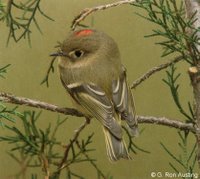 scrubby edges. That's where I spotted this season's first yellow-crowned kinglets, not considered much of a find by seasoned birders because of their larger numbers, and the less numerous, more coveted ruby-crowned kinglet. This tiny bird doesn't seem like a bird at all. It looks more like a new potato with startled eyes and toothpick legs. But then, if you're lucky, you'll get a glimpse of the patch of red on the top its head, which often is hidden from view. Much to my delight, my ruby-crowneds didn't seem the least bit inclined to hide their glory from me.
scrubby edges. That's where I spotted this season's first yellow-crowned kinglets, not considered much of a find by seasoned birders because of their larger numbers, and the less numerous, more coveted ruby-crowned kinglet. This tiny bird doesn't seem like a bird at all. It looks more like a new potato with startled eyes and toothpick legs. But then, if you're lucky, you'll get a glimpse of the patch of red on the top its head, which often is hidden from view. Much to my delight, my ruby-crowneds didn't seem the least bit inclined to hide their glory from me.When I reported to another birder who had shown up what I had seen, she said, "Those are good birds." This kind of comment really gets on my nerves. Birders tend to dismiss the ordinary birds we see every day (robins, house sparrows, rock doves [pigeons], even the magnificent Northern cardinal) and more common migrants (yellow-rumped warblers, phoebes, juncos) as "not good birds" or not "important" birds. My friend Eleanora, who is a near-expert birder, and I had a good laugh when we pursued the identification of a sparrow near the lakefront bird sanctuary while some old male birders told us we were foolish not to have gone to North Pond first to see the "important" eared grebe that had been spotted there. I'm not that kind of a birder, I admit. I enjoy bird behavior more than being able to say I've seen a certain bird. I get a kick out of the mating dance of the common house sparrow, the most successful bird on the planet, while still coveting a chance to see sandhill cranes flying high in a V-formation over the south suburbs. I simply enjoy being out in the wind and the sun, away from human commerce, hearing bird songs and feeling leaves and earth pressed softly under my feet.
Not all birders feel as I do. Let me tell you just how serious, how all-consuming birding can be. There is an event called a Big Year that a handful of expert birders decide they will do when conditions seem right. Birders on a Big Year travel all over the United States (there are Big Years in other countries and state Big Years, too) in an attempt to see as many species of birds as they can in a single year. This effort requires them to have spotters all over the country who will call them when a bird they haven't listed shows up. The Big Year birder then must hop on a plane or drive for several hours, whatever it takes, to get to the bird before it flies away. Mind you, this is a competition that is self-declared, that offers no prize money, that requires each contestant to spend many thousands of dollars, lose many nights of sleep, and brave savage weather in such places as Alaska, to win. All the winner gets is bragging rights. Now THAT's dedication.
As much as I admire the skill of the Big Year birders, I can't help but feel they are missing the point. A Big Year is more like bean counting than anything else. Show up, see the bird, add it to the list, await the next call. Me, I'd like to say I saw a bird pick up a twig or piece of lint and know it was going to be used to build its nest. I'd tell you about the house sparrows who always build a nest on my mother's drain pipe, and how a chick always falls out and how I always pick it up and put it back in the nest. I'd tell you that I saw not one, not two, but THREE yellow-bellied sapsuckers hopping along the side of a tree ready to peck a hole to build a nest. Yes, I really did. l
For insight into the world of competitive birding, I highly recommend The Big Year: A Tale of Man, Nature, and Fowl Obsession by Mark Obmascik.


2 Comments:
At 11:35 PM, Mark said…
Mark said…
I've never gotten into bird watching but I am glad for those who do because they are conservationists. We once had a bird feeder and I went to war with the squirrels on behalf of the birds, does that count?
At 9:43 AM, Marilyn said…
Marilyn said…
Of course it counts!
Actually, hunters are conservationists, too. They want the habitat saved so they can keep killing things. Kind of ironic, no?
Post a Comment
<< Home